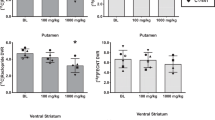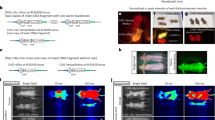Abstract
The dopamine D2 receptor (D2R) has been used in adenoviral delivery systems and in tumor cell xenografts as an in vivo reporter gene. D2R reporter gene expression has been non-invasively, repetitively and quantitatively imaged by positron emission tomography (PET), following systemic injection of a positron-labeled ligand (3-(2′-[18F]-fluoroethyl)-spiperone; FESP) and subsequent D2R-dependent sequestration. However, dopamine binding to the D2R can modulate cyclic AMP levels. For optimal utilization of D2R as a reporter gene, it is important to uncouple ligand-binding from Gi-protein-mediated inhibition of cAMP production. Mutation of Asp80 or Ser194 produces D2Rs that still bind [3H]spiperone in transfected cells. The D2R80A mutation completely eliminates the ability of the D2R to suppress forskolin-stimulated cAMP accumulation in response to dopamine, in cells transfected with a D2R80A expression plasmid and in cells infected with replication-defective adenovirus expressing D2R80A. The D2R194A mutation substantially reduces, but does not completely eliminate, dopamine modulation of cAMP levels. Cultured cells infected with adenoviruses expressing D2R and D2R80A demonstrated equivalent [3H]spiperone binding activity. Moreover, hepatic FESP sequestration is equivalent, following intravenous injection of adenoviruses expressing D2R and D2R80A. The D2R80A mutant, which can no longer modulate cAMP levels following ligand binding, has full capability as a PET reporter gene. Gene Therapy (2001) 8, 1490–1498.
This is a preview of subscription content, access via your institution
Access options
Subscribe to this journal
Receive 12 print issues and online access
$259.00 per year
only $21.58 per issue
Buy this article
- Purchase on Springer Link
- Instant access to full article PDF
Prices may be subject to local taxes which are calculated during checkout






Similar content being viewed by others
References
Contag PR et al. Bioluminescent indicators in living mammals Nature Med 1998 4: 245–247
Edinger M et al. Noninvasive assessment of tumor cell proliferation in animal models Neoplasia 1999 1: 303–310
Jacobi CA et al. In vitro and in vivo expression studies of yopE from Yersinia enterocolitica using the gfp reporter gene Mol Microbiol 1998 30: 865–882
Chishima T et al. Cancer invasion and micrometastasis visualized in live tissue by green fluorescent protein expression Cancer Res 1997 57: 2042–2047
Naumov GN et al. Cellular expression of green fluorescent protein, coupled with high-resolution in vivo videomicroscopy, to monitor steps in tumor metastasis J Cell Sci 1999 112: 1835–1842
Gambhir SS et al. Imaging transgene expression with radionuclide imaging technologies Neoplasia 2000 2: 118–138
Herschman HR et al. Seeing is believing: non-invasive, quantitative and repetitive imaging of reporter gene expression in living animals, using positron emission tomography J Neurosci Res 2000 59: 699–705
Tjuvajev J et al. Imaging herpes virus thymidine kinase gene transfer and expression by positron emission tomography Cancer Res 1998 58: 4333–4341
Gambhir SS et al. Imaging adenoviral-directed reporter gene expression in living animals with positron emission tomography Proc Natl Acad Sci USA 1999 96: 2333–2338
Gambhir SS et al. A mutant herpes simplex virus type 1 thymidine kinase reporter gene shows improved sensitivity for imaging reporter gene expression with positron emission tomography Proc Natl Acad Sci USA 2000 97: 2785–2790
MacLaren DC et al. Repetitive, non-invasive imaging of the dopamine D2 receptor as a reporter gene in living animals Gene Therapy 1999 6: 785–791
Zinn KR et al. Noninvasive monitoring of gene transfer using a reporter receptor imaged with a high-affinity peptide radiolabeled with 99mTc or 188Re J Nucl Med 2000 41: 887–895
Phelps ME . Positron emission tomography provides molecular imaging of biological processes Proc Natl Acad Sci USA 2000 97: 9226–9233
Cherry SR et al. MicroPET: a high resolution PET scanner for imaging small animals IEEE Trans Nucl Sci 1997 44: 1109–1143
Chatziioannou AF et al. Performance evaluation of microPET: a high resolution leutetium oxyorthosilicate PET scanner for animal imaging J Nucl Med 1999 40: 1164–1175
Neve KA et al. Pivotal role for aspartate-80 in the regulation of dopamine D2 receptor affinity for drugs and inhibition of adenylyl cyclase Mol Pharmacol 1991 39: 733–739
Cox BA et al. Contributions of conserved serine residues to the interactions of ligands with dopamine D2 receptors J Neurochem 1992 59: 627–635
Woodward R et al. Investigation of the role of conserved serine residues in the long form of the rat D2 dopamine receptor using site-directed mutagenesis J Neurochem 1996 66: 394–402
Watts VJ et al. Selective activation of Gαo by D2L dopamine receptors in NS20Y neuroblastoma cells J Neurosci 1998 18: 8692–8699
Yu Y et al. Quantification of target gene expression by imaging reporter gene expression in living animals Nat Med 2000 6: 933–937
Yaghoubi S et al. Human pharmacokinetic and dosimetry studies of [18F]-FHBG, a reporter probe for imaging herpes simplex virus type 1 thymidine kinase (HSV1-tk) reporter gene expression J Nucl Med (in press)
Herz J, Gerard RD . Adenovirus-mediated transfer of low density lipoprotein receptor gene acutely accelerates cholesterol clearance in normal mice Proc Natl Acad Sci USA 1993 90: 2812–2816
Vile RG, Diaz RM, Castleden S, Chong H . Targeted gene therapy for cancer: herpes simplex virus thymidine kinase gene-mediated cell killing leads to anti-tumour immunity that can be augmented by co-expression of cytokines in the tumour cells Biochem Soc Trans 1997 25: 717–722
Mesnil M, Yamasaki H . Bystander effect in herpes simplex virus-thymidine kinase/ganciclovir cancer gene therapy: role of gap-junctional intercellular communication Cancer Res 2000 60: 3989–3999
Sandmair AM, Vapalahti M, Yla-Herttuala S . Adenovirus-mediated herpes simplex thymidine kinase gene therapy for brain tumors Adv Exp Med Biol 2000 465: 163–170
Pages P et al. sst2 somatostatin receptor mediates cell cycle arrest and induction of p27(Kip1). Evidence for the role of SHP-1 J Biol Chem 1999 274: 15186–15193
Weissleder R et al. In vivo magnetic resonance imaging of transgene expression Nat Med 2000 6: 351–355
Horton RM et al. Engineering hybrid genes without the use of restriction enzymes: gene splicing by overlap extension Gene 1989 77: 61–68
Liang Q, Chen L, Fulco AJ . An efficient and optimized PCR method with high fidelity for site-directed mugagenesis PCR Meth Appl 1995 4: 269–274
Gomez-Foix AM et al. Adenovirus-mediated transfer of the muscle glycogen phosphorylase gene into hepatocytes confers altered regulation of glycogen metabolism J Biol Chem 1992 267: 25129–25134
Graham FL, van der Eb AJ . A new technique for the assay of infectivity of human adenovirus 5 DNA Virology 1973 52: 456–467
Qi J et al. High-resolution 3D Bayesian image reconstruction using the microPET small-animal scanner Phys Med Biol 1998 43: 1001–1013
Acknowledgements
We thank Art Catapang, Raymond Basconcillo, Judy Edwards, Khoi Nguyen, Waldemar Ladno and ManKit Ho for technical assistance, Dr K Neve for advice on cyclic AMP stimulation and analysis and Duncan MacLaren for instruction in the [3H]spiperone binding assay. This work was supported by Department of Energy award DE-FC03–87ER60615, NIH award R0–1 CA84572 (HRH) and NIH award P50 CA86306 (HRH).
Author information
Authors and Affiliations
Rights and permissions
About this article
Cite this article
Liang, Q., Satyamurthy, N., Barrio, J. et al. Noninvasive, quantitative imaging in living animals of a mutant dopamine D2 receptor reporter gene in which ligand binding is uncoupled from signal transduction. Gene Ther 8, 1490–1498 (2001). https://doi.org/10.1038/sj.gt.3301542
Received:
Accepted:
Published:
Issue Date:
DOI: https://doi.org/10.1038/sj.gt.3301542
Keywords
This article is cited by
-
Quantitative Rodent Brain Receptor Imaging
Molecular Imaging and Biology (2020)
-
Angiotensin II increases gene expression after selective intra-arterial adenovirus delivery in a rabbit model assessed using in vivo SSTR2-based reporter imaging
EJNMMI Research (2016)
-
Applications of In Vivo Imaging in the Evaluation of the Pathophysiology of Viral and Bacterial Infections and in Development of Countermeasures to BSL3/4 Pathogens
Molecular Imaging and Biology (2015)
-
Radiolabeling Strategies for Radionuclide Imaging of Stem Cells
Stem Cell Reviews and Reports (2015)
-
Quantitative, noninvasive, in vivo longitudinal monitoring of gene expression in the brain by co-AAV transduction with a PET reporter gene
Molecular Therapy - Methods & Clinical Development (2014)



